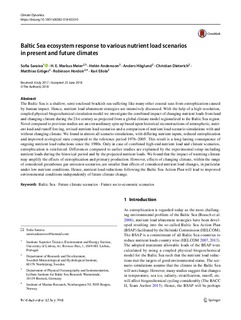| dc.description.abstract | The Baltic Sea is a shallow, semi-enclosed brackish sea suffering like many other coastal seas from eutrophication caused by human impact. Hence, nutrient load abatement strategies are intensively discussed. With the help of a high-resolution, coupled physical-biogeochemical circulation model we investigate the combined impact of changing nutrient loads from land and changing climate during the 21st century as projected from a global climate model regionalized to the Baltic Sea region. Novel compared to previous studies are an extraordinary spin-up based upon historical reconstructions of atmospheric, nutrient load and runoff forcing, revised nutrient load scenarios and a comparison of nutrient load scenario simulations with and without changing climate. We found in almost all scenario simulations, with differing nutrient inputs, reduced eutrophication and improved ecological state compared to the reference period 1976–2005. This result is a long-lasting consequence of ongoing nutrient load reductions since the 1980s. Only in case of combined high-end nutrient load and climate scenarios, eutrophication is reinforced. Differences compared to earlier studies are explained by the experimental setup including nutrient loads during the historical period and by the projected nutrient loads. We found that the impact of warming climate may amplify the effects of eutrophication and primary production. However, effects of changing climate, within the range of considered greenhouse gas emission scenarios, are smaller than effects of considered nutrient load changes, in particular under low nutrient conditions. Hence, nutrient load reductions following the Baltic Sea Action Plan will lead to improved environmental conditions independently of future climate change. | nb_NO |
